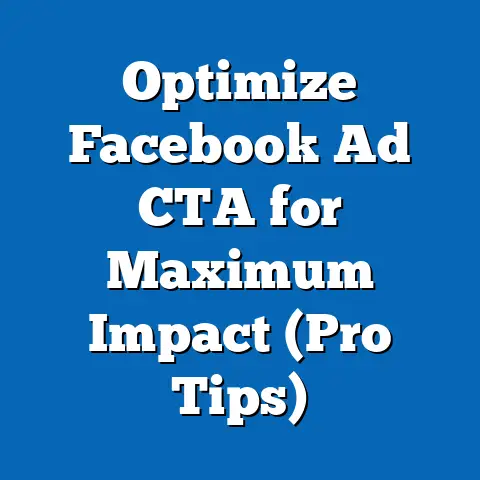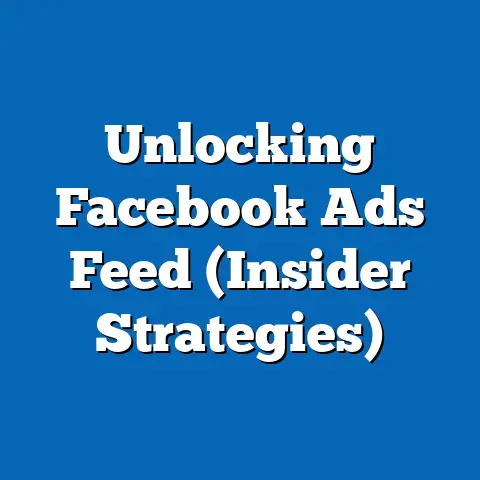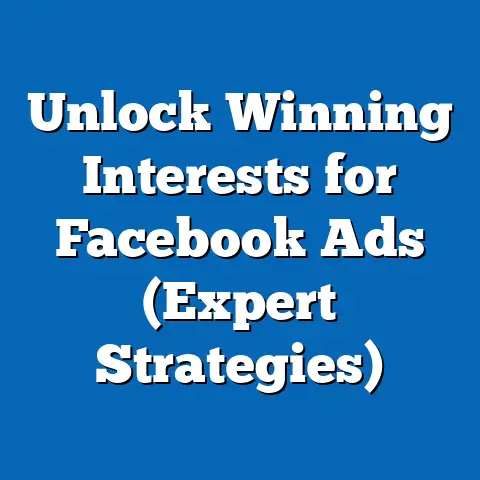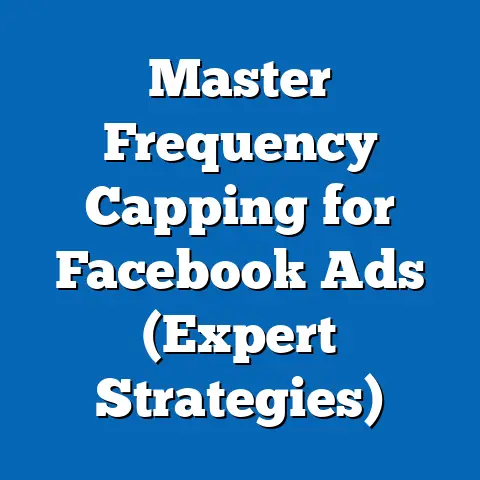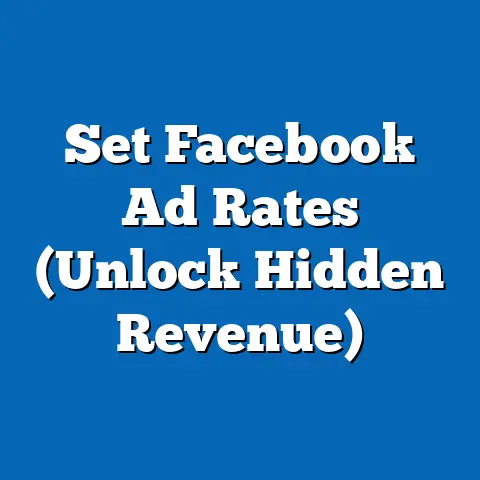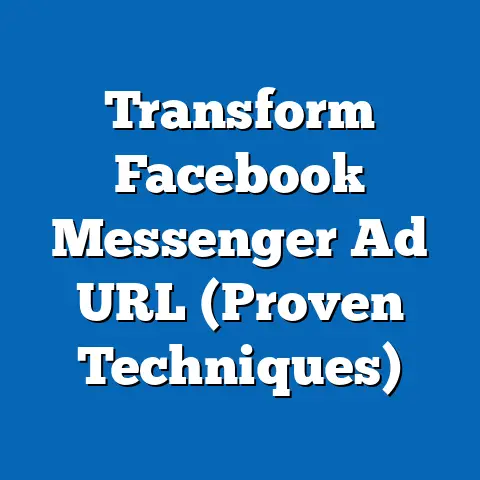Master Tiny Facebook Ads Design (Pro Tips Unveiled)
The world of digital marketing is a noisy place. Every day, users are bombarded with countless ads vying for their attention. In this chaotic landscape, the secret weapon of savvy marketers is often overlooked: the “tiny Facebook ad.” I’m not talking about low-budget campaigns, but rather ads designed with a minimalist approach – small in visual footprint but mighty in impact. Think of it as the digital equivalent of a perfectly crafted haiku: concise, evocative, and unforgettable.
Why focus on shrinking your ad presence? Because sometimes, less truly is more. Overly complex or visually cluttered ads often get lost in the shuffle. In contrast, a well-designed, minimalist ad can cut through the noise, capture attention instantly, and deliver a clear message that resonates with your target audience.
I’ve seen this firsthand. Early in my career, I was tasked with revitalizing a struggling campaign for a local bakery. We were throwing everything at the wall – carousel ads, video ads, long-form copy – and nothing was sticking. Then, on a whim, I stripped everything back. We created a simple image of a freshly baked croissant, paired it with the tagline “Morning Bliss,” and targeted it at people within a 5-mile radius. The results were astounding. We saw a significant increase in click-through rates and, more importantly, a surge in in-store traffic.
That experience taught me the power of simplicity, and it’s a lesson I’ve carried with me ever since. In this article, I’m going to share my pro tips for mastering the art of tiny Facebook ads design. We’ll delve into the essential design elements, explore the secrets of compelling copy, discuss the importance of testing and optimization, and examine real-world case studies that demonstrate the effectiveness of this often-underestimated strategy. Get ready to unlock the full potential of your Facebook advertising by embracing the power of “tiny.”
Understanding the Power of Minimalism in Ad Design
Minimalism, in the context of Facebook ads, isn’t just about making things look “clean” or “modern.” It’s a deliberate design philosophy that prioritizes clarity, focus, and impact. It’s about stripping away unnecessary elements to reveal the core message and value proposition. Think of it as decluttering your visual space to make room for what truly matters.
Why is minimalism so effective? Several reasons contribute to its power:
- Improved Comprehension: Simpler designs are easier to understand. Users can quickly grasp the message without feeling overwhelmed or confused.
- Enhanced Engagement: A clean, uncluttered ad can be more visually appealing and engaging, encouraging users to click and learn more.
- Increased Brand Recognition: Minimalist branding can be more memorable and recognizable, helping your brand stand out in a crowded feed.
- Faster Loading Times: Simpler designs often translate to smaller file sizes, resulting in faster loading times and a better user experience.
Statistics consistently support the effectiveness of minimalist design. A study by the Nielsen Norman Group found that users prefer simple designs over complex ones, and that simplicity leads to higher satisfaction and engagement. Furthermore, a report by HubSpot revealed that minimalist landing pages often have higher conversion rates than those with cluttered designs.
Consider the example of Apple. Their advertising is a masterclass in minimalism. They use clean lines, simple imagery, and concise copy to showcase the elegance and functionality of their products. This approach has helped them build a strong brand identity and connect with customers on an emotional level. Similarly, brands like Everlane and Casper have successfully leveraged minimalism in their Facebook ad campaigns to convey their values of transparency and simplicity.
The takeaway here is clear: minimalism is not a trend, but a powerful design strategy that can significantly improve the effectiveness of your Facebook ads. By embracing simplicity, you can create ads that are more engaging, memorable, and ultimately, more profitable.
Essential Design Elements for Tiny Facebook Ads
Creating a compelling tiny Facebook ad is like composing a miniature work of art. Every element must be carefully considered and perfectly balanced to achieve maximum impact. Here’s a breakdown of the essential design components:
Color Psychology
Color isn’t just about aesthetics; it’s a powerful tool that can influence emotions, perceptions, and behavior. Different colors evoke different feelings, and choosing the right color palette for your ad can significantly impact its performance.
- Blue: Often associated with trust, reliability, and security. Ideal for financial institutions, healthcare providers, and technology companies.
- Green: Evokes feelings of nature, health, and growth. Suitable for eco-friendly brands, organic food companies, and wellness products.
- Yellow: Represents optimism, energy, and happiness. Effective for attracting attention and promoting sales or discounts.
- Red: Conveys excitement, passion, and urgency. Can be used to create a sense of urgency or to highlight special offers.
- Purple: Associated with luxury, creativity, and wisdom. Ideal for high-end brands, artistic products, and educational services.
I remember working on a campaign for a local spa. Initially, we used a vibrant, multi-colored design, thinking it would appeal to a broad audience. However, the results were underwhelming. After some research, we realized that our target audience – busy professionals seeking relaxation – were more likely to respond to calming, soothing colors. We switched to a palette of soft blues and greens, and the ad performance immediately improved.
Typography
In a tiny ad, every letter counts. Choosing the right font is crucial for ensuring readability and conveying the right tone.
- Font Selection: Opt for fonts that are clear, legible, and easy to read at small sizes. Avoid overly ornate or decorative fonts.
- Font Size: Ensure that the font size is large enough to be easily readable, but not so large that it overwhelms the design.
- Font Pairing: If you’re using multiple fonts, choose fonts that complement each other and create a harmonious visual hierarchy.
- Line Height and Spacing: Pay attention to line height and spacing to improve readability and prevent the text from feeling cramped.
I’ve seen many ads fail simply because the font was too small or too difficult to read. Remember, users are scrolling quickly through their feeds, so you have a limited amount of time to capture their attention. Make sure your text is easy to scan and understand at a glance.
Imagery
A picture is worth a thousand words, and in a tiny ad, a compelling image can speak volumes.
- High-Quality Images: Use images that are sharp, clear, and visually appealing. Avoid blurry or pixelated images.
- Relevance: Choose images that are relevant to your product, service, or message.
- Emotional Connection: Select images that evoke emotions and connect with your target audience on a personal level.
- Simplicity: In a tiny ad, less is often more. Opt for images that are simple, uncluttered, and easy to understand.
I once worked on a campaign for a travel agency. Instead of using generic stock photos of beaches and landmarks, we used user-generated content – photos taken by real travelers who had booked trips through the agency. This approach not only added authenticity to the ad but also created a sense of community and connection.
Branding
Consistency is key when it comes to branding. Your tiny ad should seamlessly integrate with your overall brand identity.
- Logo Placement: Include your logo in a prominent but not overwhelming location.
- Color Palette: Use your brand’s color palette to create a cohesive visual identity.
- Font Consistency: Use your brand’s fonts to maintain a consistent look and feel.
- Messaging: Ensure that your ad’s messaging aligns with your brand’s values and voice.
I always advise my clients to create a brand style guide that outlines their logo usage, color palette, font choices, and messaging guidelines. This helps ensure consistency across all marketing materials, including Facebook ads.
By mastering these essential design elements, you can create tiny Facebook ads that are visually appealing, engaging, and effective at communicating your message.
Crafting Compelling Copy for Tiny Ads
In the world of tiny Facebook ads, your copy is the unsung hero. It’s the voice that amplifies your visual message, the storyteller that captivates your audience, and the call-to-action that drives conversions. But with limited space, every word needs to pack a punch. Here’s how to craft compelling copy that makes a big impact in a small space:
- Concise and Impactful Headlines: Your headline is your first (and often only) chance to grab attention. Keep it short, punchy, and benefit-driven. Focus on the core value proposition of your product or service. Instead of “We offer the best coffee,” try “Start Your Day with the Perfect Cup.”
- Persuasive Calls to Action (CTAs): Your CTA is the final nudge that encourages users to take action. Use strong, action-oriented verbs that clearly communicate what you want them to do. Instead of “Learn More,” try “Shop Now,” “Get Started,” or “Claim Your Discount.”
- Value Propositions: Succinctly convey the value of your product or service. What problem does it solve? What benefits does it offer? Focus on the “what’s in it for me” for your target audience.
- Target Audience Language: Tailor your language to resonate with your specific target audience. Use the words and phrases that they use, and speak to their specific needs and interests.
I’ve learned that the best way to write compelling copy is to understand your audience intimately. Conduct thorough research to identify their pain points, desires, and motivations. Use this knowledge to craft copy that speaks directly to their needs and offers a solution to their problems.
Consider this example: a tiny ad for a language learning app. Instead of a generic headline like “Learn a New Language,” a more compelling headline might be “Speak Spanish in 30 Days.” This headline is concise, benefit-driven, and creates a sense of urgency. The CTA could be “Start Your Free Trial,” which is clear, action-oriented, and encourages immediate engagement.
Another effective technique is to use storytelling to connect with your audience on an emotional level. Share a brief anecdote or testimonial that highlights the benefits of your product or service. Even in a tiny ad, a well-crafted story can leave a lasting impression.
Remember, every word in your tiny ad matters. Choose your words carefully, focus on the benefits, and speak directly to your target audience. With a little creativity and attention to detail, you can craft compelling copy that drives results.
Testing and Optimizing Tiny Facebook Ads
Creating a great tiny ad is just the first step. The real magic happens when you start testing and optimizing your ads based on real-world performance data. A/B testing is your best friend in this process. It allows you to compare different versions of your ad to see which one performs better.
Here are some key metrics to monitor for tiny ads:
- Click-Through Rate (CTR): This measures the percentage of people who see your ad and click on it. A higher CTR indicates that your ad is engaging and relevant to your target audience.
- Conversion Rate: This measures the percentage of people who click on your ad and then complete a desired action, such as making a purchase or filling out a form. A higher conversion rate indicates that your ad is effectively driving results.
- Cost Per Click (CPC): This measures the cost you pay each time someone clicks on your ad. A lower CPC indicates that your ad is efficient at driving traffic.
- Cost Per Acquisition (CPA): This measures the cost you pay for each conversion. A lower CPA indicates that your ad is effectively driving results at a reasonable cost.
I always recommend starting with a clear hypothesis. What do you think will improve your ad’s performance? For example, you might hypothesize that changing the headline will increase your CTR. Then, create two versions of your ad – one with the original headline and one with the new headline – and run them simultaneously.
Once you’ve gathered enough data, analyze the results to see which version performed better. If the new headline significantly increased your CTR, then you can confidently implement it in your ad campaign.
Don’t be afraid to experiment with different design elements, copy variations, and targeting options. The more you test, the more you’ll learn about what works best for your target audience.
Remember, testing and optimization is an ongoing process. The Facebook advertising landscape is constantly evolving, so it’s important to continuously monitor your ad performance and make adjustments as needed.
Case Studies of Successful Tiny Facebook Ads
Let’s dive into some real-world examples of brands that have successfully leveraged tiny ad designs in their Facebook campaigns:
Case Study 1: Dollar Shave Club
- Objective: Increase brand awareness and drive new subscriptions.
- Strategy: Dollar Shave Club is known for its witty and irreverent marketing. They created a series of tiny video ads that were short, humorous, and highly shareable. These ads featured their founder, Michael Dubin, delivering a quirky sales pitch.
- Results: The ads went viral, generating millions of views and driving a significant increase in subscriptions.
- Key Takeaways: Humor can be a powerful tool for capturing attention and engaging your target audience. Keep your message concise and benefit-driven.
Case Study 2: Warby Parker
- Objective: Drive online sales of eyeglasses.
- Strategy: Warby Parker is known for its stylish and affordable eyeglasses. They created a series of tiny image ads that featured high-quality photos of their glasses, paired with simple and elegant copy.
- Results: The ads drove a significant increase in online sales and helped Warby Parker establish itself as a leading brand in the eyewear industry.
- Key Takeaways: High-quality visuals are essential for showcasing your products. Use simple and elegant copy to highlight the key features and benefits.
Case Study 3: Airbnb
- Objective: Increase bookings of unique accommodations.
- Strategy: Airbnb created a series of tiny image ads that featured stunning photos of unique accommodations around the world, paired with evocative copy that inspired wanderlust.
- Results: The ads drove a significant increase in bookings and helped Airbnb establish itself as a leading brand in the travel industry.
- Key Takeaways: Evoke emotions and inspire your target audience with compelling visuals and copy. Highlight the unique experiences that your product or service offers.
These case studies demonstrate the power of tiny Facebook ads when executed effectively. By focusing on simplicity, clarity, and emotional connection, these brands were able to capture attention, engage their target audience, and drive significant results.
Conclusion
Mastering the art of tiny Facebook ads design is not just about aesthetics; it’s about strategic thinking, understanding your audience, and leveraging the power of simplicity. By embracing minimalism, focusing on essential design elements, crafting compelling copy, and continuously testing and optimizing your ads, you can unlock the full potential of your Facebook advertising.
I’ve shared my pro tips, now it’s your turn to put them into practice. Experiment with different designs, copy variations, and targeting options. Don’t be afraid to try new things and push the boundaries of creativity. The key is to continuously learn, adapt, and refine your approach based on real-world performance data.
Remember, in the crowded landscape of digital marketing, sometimes the smallest voice can be the loudest. By mastering the art of tiny Facebook ads design, you can cut through the noise, capture attention, and achieve remarkable results.
Call to Action:
I’d love to hear about your experiences with tiny Facebook ads. Share your own tips, success stories, or questions in the comments section below. And don’t forget to subscribe for more insights on Facebook advertising and digital marketing strategies.

